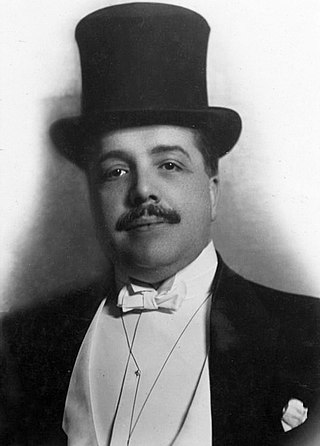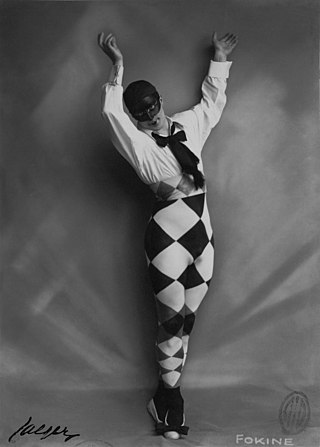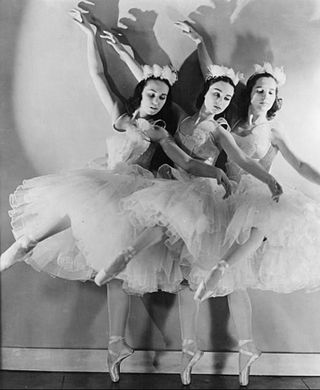
Sergei Pavlovich Diaghilev, also known as Serge Diaghilev, was a Russian art critic, patron, ballet impresario and founder of the Ballets Russes, from which many famous dancers and choreographers would arise.

Vaslav or Vatslav Nijinsky was a Russian ballet dancer and choreographer of Polish ancestry. He is regarded as the greatest male dancer of the early 20th century. He was celebrated for his virtuosity and for the depth and intensity of his characterizations. He could dance en pointe, a rare skill among male dancers at the time, and was admired for his seemingly gravity-defying leaps.

Anna Pavlovna Pavlova was a Russian prima ballerina of the late 19th and the early 20th centuries. She was a principal artist of the Imperial Russian Ballet and the Ballets Russes of Sergei Diaghilev. Pavlova is most recognized for her creation of the role of The Dying Swan and, with her own company, became the first ballerina to tour around the world, including performances in South America, India, Mexico and Australia.

Michael Fokine was a Russian choreographer and dancer.

Bronislava Nijinska was a Russian ballet dancer of Polish origin, and an innovative choreographer. She came of age in a family of traveling, professional dancers.

Mikhail Mordkin graduated from the Bolshoi Ballet School in 1899, and in the same year was appointed ballet master.

The ballet, The Afternoon of a Faun, was choreographed by Vaslav Nijinsky for the Ballets Russes, and was first performed in the Théâtre du Châtelet in Paris on 29 May 1912. Nijinsky danced the main part himself. The music is Claude Debussy's symphonic poem Prélude à l'après-midi d'un faune. Both the music and the ballet were inspired by the poem L'Après-midi d'un faune by Stéphane Mallarmé. The costumes, sets and programme illustrations were designed by the painter Léon Bakst.

Russian ballet is a form of ballet characteristic of or originating from Russia.

Tamara Platonovna Karsavina was a Russian prima ballerina, renowned for her beauty, who was a principal artist of the Imperial Russian Ballet and later of the Ballets Russes of Sergei Diaghilev. After settling in Britain at Hampstead in London, she began teaching ballet professionally and became recognised as one of the founders of modern British ballet. She assisted in the establishment of The Royal Ballet and was a founder member of the Royal Academy of Dance, which is now the world's largest dance-teaching organisation.

Mathilde-Marie Feliksovna Kschessinska was a Polish/Russian ballerina from the noble family Krzesiński. Her father Feliks Krzesiński and her brother both danced in Saint Petersburg. She was a mistress of the future Emperor Nicholas II of Russia before his marriage, and later the wife of his cousin Grand Duke Andrei Vladimirovich of Russia.

Pavel Andreyevich Gerdt, also known as Paul Gerdt, was the Premier Danseur Noble of the Imperial Ballet, the Bolshoi Kamenny Theatre, and the Mariinsky Theatre for 56 years, making his debut in 1860, and retiring in 1916. His daughter Elizaveta Gerdt was also a prominent ballerina and teacher.

The Ballets Russes was an itinerant ballet company begun in Paris that performed between 1909 and 1929 throughout Europe and on tours to North and South America. The company never performed in Russia, where the Revolution disrupted society. After its initial Paris season, the company had no formal ties there.

Le Spectre de la rose is a short ballet about a young girl who dreams of dancing with the spirit of a souvenir rose from her first ball. The ballet was written by Jean-Louis Vaudoyer who based the story on a verse by Théophile Gautier and used the music of Carl Maria von Weber's piano piece Aufforderung zum Tanz as orchestrated by Hector Berlioz.

The Vaganova Academy of Russian Ballet is a school of classical ballet in St Petersburg, Russia. Established in 1738 during the reign of Empress Anna, the academy was known as the Imperial Ballet School until the Soviet era, when, after a brief hiatus, the school was re-established as the Leningrad State Choreographic Institute. In 1957, the school was renamed in honor of the pedagogue Agrippina Vaganova, who cultivated the method of classical ballet training that has been taught there since the late 1920s. Many of the world's leading ballet schools have adopted elements of the Vaganova method into their own training.

The company Ballets Russes de Monte-Carlo was formed in 1932 after the death of Sergei Diaghilev and the demise of Ballets Russes. Its director was Wassily de Basil, and its artistic director was René Blum. They fell out in 1936 and the company split. The part which de Basil retained went through two name changes before becoming the Original Ballet Russe. Blum founded Les Ballets de Monte Carlo, which changed its name to Ballet Russe de Monte Carlo when Léonide Massine became artistic director in 1938. It operated under this name until it disbanded some 20 years later.
The Original Ballet Russe was a ballet company established in 1931 by René Blum and Colonel Wassily de Basil as a successor to the Ballets Russes, founded in 1909 by Sergei Diaghilev. The company assumed the new name Original Ballet Russe after a split between de Basil and Blum. De Basil led the renamed company, while Blum and others founded a new company under the name Ballet Russe de Monte-Carlo. It was a large scale professional ballet company which toured extensively in Europe, Australia and New Zealand, the United States, and Central and South America. It closed down operations in 1947.

Pierre Vladimiroff, or Pyotr Nikolayevich Vladimirov, was a Russian dancer and teacher.
Galina Viktorovna Belyaeva is a Soviet and Russian film and theatre actress, best known for her leading roles in A Hunting Accident (1977) and Anna Pavlova (1983). Belyaeva, the Meritorious Artist of Russia (2003), has been one of the leading actresses at the Moscow Mayakovsky Theatre since 1983.

Elena Smirnova was the last prima ballerina of the Mariinsky Theater in the Imperial period of Russia. Starring in many leading roles, she often performed choreography created by Marius Petipa and Boris G. Romanov. Participating in early films of Germany and Russia, she made eight silent films and participated in the premiers of both the Ballets Russes in Paris and in the first performance of Russian ballet in Japan.

Vera Mikhailovna Krasovskaya was a Russian ballet historian, critic and dancer. She began her dancing career at the Leningrad Ballet School and graduated from it in 1933. Krasovskaya performed with the Kirov Ballet at the Mariinsky Theatre from 1933 to 1941 before stepping down to become a critic and studied at the Leningrad Ostrovsky Institute of Theatre. She published two volumes of four books on Russian ballet and went on to author a larger second volume focus on the history of ballet in Western Europe. Krasovskaya also wrote biographies on Anna Pavlova, Vaslav Nijinsky, Natalia Dudinskaya, Irina Kolpakova, Nikita Dolgushin and Agrippina Vaganova. She was awarded the Triumph Prize in December 1998 for her contribution to Russian culture.


















